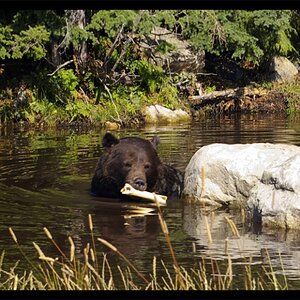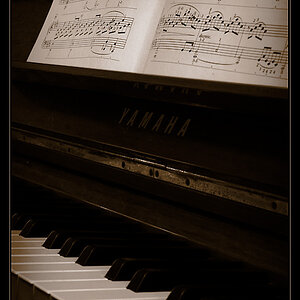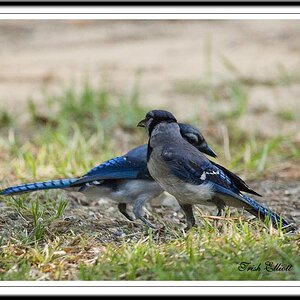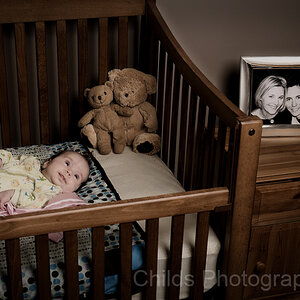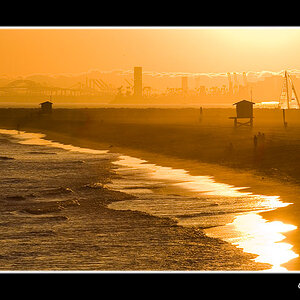Tim Tucker
No longer a newbie, moving up!
- Joined
- Mar 23, 2015
- Messages
- 660
- Reaction score
- 579
- Can others edit my Photos
- Photos NOT OK to edit
I'd like to explore a theme I started with some comments I made on an image. You are all aware that if you take a picture of somebody on a sunny day and paste it on a background taken on a dull overcast day then nearly all will notice the inconsistencies (but not everybody will) and see it clearly as one image pasted on another.
So why do fewer notice when you reduce a background to pure black? A flat black is completely void of tone, texture and colour. It is very different in nature to the image displayed upon it.
It is not noticed so much because people usually just glance at things an make assumptions. We assume the black is the background and in the absence of any data that contradicts this we just fail to look at it and notice how it differs. So I'd like to look a little closer, explain a little about visual images and show you what is clear and obvious to me.
We will start with a section of one of my images, that I'll use as an example throughout. I'm going to play around with it, adjusting it and hopefully show you a little more about how images work.
Here's the image:
View attachment 124507
Flowers against a background. Or is it? It is a visual image and as such it is only 2D, it has no depth and it has no background. You cannot differentiate between foreground and background by distance as both are exactly the same distance from the eye. So we do it by interpreting other visual clues contained in the image. The flowers are complete, the background truncated, the background is consistent, the lighter brighter shades of the flowers naturally come forward against the darker red. There are many clues that connect the foreground with the background and allow us to see it as being consistent and allow the illusion that one thing is in front of another; shadows, transparency in foreground objects, light reflected on foreground objects from the background, depth of field, etc. The clues are in the relationship between the foreground and background. So what happens if we remove the clues from one part of the image, the background, how is our perception altered?
First I'll make the background a little darker and see what happens:
View attachment 124509
You will notice that as the separation between the lighting conditions is exaggerated so the connection between the two begins to get stretched. It looks less convincing in the areas that have a higher contrast in luminosity against the background, on the right where the transition is less abrupt it still convinces. There is still a connection between the foreground and background and you can still read the clues in both. It is not just the flowers saying, "I'm in front," but also the background saying, "I'm behind."
A bit darker still:
View attachment 124510
Here it is when I remove the visual clues from the background:
View attachment 124511
Before I discuss this I'd like to show you the true nature of the image, and also to remove your assumption that one is in front of another. I'll do this with the simple visual clue of overlap:
Here the flowers are in front of the background:
View attachment 124512
This is the true nature of the image, one thing is not in front of the other, the background does not extend behind the flowers, they are just assumptions you make based on the visual clues you are given.The image is just a series of tones, textures and colours on a 2D surface.
Here it is the other way around:
View attachment 124513
Here I've used a stronger visual clue that over-rides your assumption that one thing is in front of another. It's easy to convince because the background has no relationship with the flowers. We removed it by changing it to the black point, because we did this we made it ambiguous, it's just a black cut-out. It is not easy to convince when you do the same trick with the original image because the background does not have this ambiguity we can't just bring it forward to in front of the flowers. It only really works when you remove the relationship, then the background easily becomes just a cut-out:
View attachment 124514
We always make the assumption that the lighter object is in front of the black and many look no further. But if you are familiar with the effect and how you can play with it the black becomes more of a cut-out that can either be behind or in front. It is where the change in contrast is most abrupt that this ambiguity is most visible. This is what I see clearly, where the transition is most abrupt I see no visual indicators that tell me one thing is in front of another. By removing the visual clues from the background it becomes ambiguous and can be either and neither at the same time, it's floating.
Here it is again:
View attachment 124511
EDIT: This also hints at what I consider to be the most fundamental principle of visual imaging. If you look at the right side and especially the darker shoots then you will see that there is virtually no ambiguity between foreground and background. In fact it looks quite real and natural. So you must make the assumption that it is not a absolute quality of using the black point that creates this effect, otherwise it's inclusion would produce the effect over the entire image. The effect is entirely down to the relative difference between the black and what you place next to it. Visual effects are contained in relative difference between values and not their absolute quality.
So why do fewer notice when you reduce a background to pure black? A flat black is completely void of tone, texture and colour. It is very different in nature to the image displayed upon it.
It is not noticed so much because people usually just glance at things an make assumptions. We assume the black is the background and in the absence of any data that contradicts this we just fail to look at it and notice how it differs. So I'd like to look a little closer, explain a little about visual images and show you what is clear and obvious to me.
We will start with a section of one of my images, that I'll use as an example throughout. I'm going to play around with it, adjusting it and hopefully show you a little more about how images work.
Here's the image:
View attachment 124507
Flowers against a background. Or is it? It is a visual image and as such it is only 2D, it has no depth and it has no background. You cannot differentiate between foreground and background by distance as both are exactly the same distance from the eye. So we do it by interpreting other visual clues contained in the image. The flowers are complete, the background truncated, the background is consistent, the lighter brighter shades of the flowers naturally come forward against the darker red. There are many clues that connect the foreground with the background and allow us to see it as being consistent and allow the illusion that one thing is in front of another; shadows, transparency in foreground objects, light reflected on foreground objects from the background, depth of field, etc. The clues are in the relationship between the foreground and background. So what happens if we remove the clues from one part of the image, the background, how is our perception altered?
First I'll make the background a little darker and see what happens:
View attachment 124509
You will notice that as the separation between the lighting conditions is exaggerated so the connection between the two begins to get stretched. It looks less convincing in the areas that have a higher contrast in luminosity against the background, on the right where the transition is less abrupt it still convinces. There is still a connection between the foreground and background and you can still read the clues in both. It is not just the flowers saying, "I'm in front," but also the background saying, "I'm behind."
A bit darker still:
View attachment 124510
Here it is when I remove the visual clues from the background:
View attachment 124511
Before I discuss this I'd like to show you the true nature of the image, and also to remove your assumption that one is in front of another. I'll do this with the simple visual clue of overlap:
Here the flowers are in front of the background:
View attachment 124512
This is the true nature of the image, one thing is not in front of the other, the background does not extend behind the flowers, they are just assumptions you make based on the visual clues you are given.The image is just a series of tones, textures and colours on a 2D surface.
Here it is the other way around:
View attachment 124513
Here I've used a stronger visual clue that over-rides your assumption that one thing is in front of another. It's easy to convince because the background has no relationship with the flowers. We removed it by changing it to the black point, because we did this we made it ambiguous, it's just a black cut-out. It is not easy to convince when you do the same trick with the original image because the background does not have this ambiguity we can't just bring it forward to in front of the flowers. It only really works when you remove the relationship, then the background easily becomes just a cut-out:
View attachment 124514
We always make the assumption that the lighter object is in front of the black and many look no further. But if you are familiar with the effect and how you can play with it the black becomes more of a cut-out that can either be behind or in front. It is where the change in contrast is most abrupt that this ambiguity is most visible. This is what I see clearly, where the transition is most abrupt I see no visual indicators that tell me one thing is in front of another. By removing the visual clues from the background it becomes ambiguous and can be either and neither at the same time, it's floating.
Here it is again:
View attachment 124511
EDIT: This also hints at what I consider to be the most fundamental principle of visual imaging. If you look at the right side and especially the darker shoots then you will see that there is virtually no ambiguity between foreground and background. In fact it looks quite real and natural. So you must make the assumption that it is not a absolute quality of using the black point that creates this effect, otherwise it's inclusion would produce the effect over the entire image. The effect is entirely down to the relative difference between the black and what you place next to it. Visual effects are contained in relative difference between values and not their absolute quality.
Last edited:




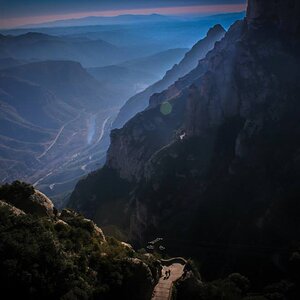


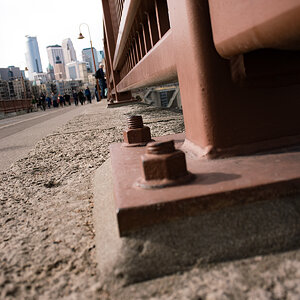
![[No title]](/data/xfmg/thumbnail/36/36394-700ff78d7b45c663863e641a9bcf1fe1.jpg?1619737548)
